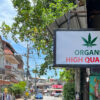To evaluate hallucinogen use trends prevalent within the American population a team of researchers analyzed data from the National Survey on Drug Use and Health (NSDUH) between 2002-2019.
On Thursday, the Columbia University Mailman School of Public Health and Irving Medical Center released information documenting the growing popularity of hallucinogen use in the United States and its inherent risks.
The findings from the newly released study were published in the peer-reviewed academic journal Addiction, and the research was also supported by the National Institute on Drug Abuse.

Photo via Addiction
Read more: Phillips Lytle announces the inception of its Psychedelic & Mental Health Therapies Practice
Read more: Cybin receives Schedule I DEA license for CYB003 trial
According to the study, hallucinogen use in the U.S. has increased overall since 2015, particularly among those 26 years of age or older.
The rate of LSD use specifically increased overall and in all age groups between 2002-2019 and for those 18-25 years old the percentage of users shot up from 0.9 per cent in 2002 to 4 per cent in 2019 — according to Columbia.
“Given the recent media coverage showing that an increasing number of adults may be reporting positive effects of ‘microdosing’ and expecting therapeutic benefits of hallucinogens without negative effects, our findings merit a comprehensive examination of time trends and motives for hallucinogen frequency and quantity of use,” said Ofir Livne, MD, MPH, a postdoctoral fellow in the Department of Epidemiology at Columbia Mailman School.
The investigators also say that between 2002-2014 the prevalence of people who perceived substantial risks to be associated with the regular use of LSD decreased significantly among all age groups.
“Our finding of an upward trend in 12-month LSD use, overall and by age, matches our finding of a downward trend in perception of LSD as risky,” said Deborah Hasin, PhD, professor of epidemiology (in psychiatry) at the Columbia University Irving Medical Center, and senior author.
“Factors such as changes in risk perception, in the specific types of drugs available and in expectations of beneficial effects of ‘microdosing’ may all have led to increased use of certain hallucinogens in recent years,” she continued.
The researchers claim that this study is the first to offer a proper statistical analysis regarding trends associated with hallucinogen use among the general population and specific age groups over the course of the last two decades.
“In light of popular media reports of a forthcoming ‘psychedelic revolution’ with commercialization and marketing that may further reduce the public perception of any risk, researchers, clinicians, and policymakers should increase their attention to the rising rates of unsupervised hallucinogen use among the general public,” added Hasin.
“Our results highlight such use as a growing public health concern and suggest that the increasing risk of potentially unsupervised hallucinogen use warrants preventive strategies.”














